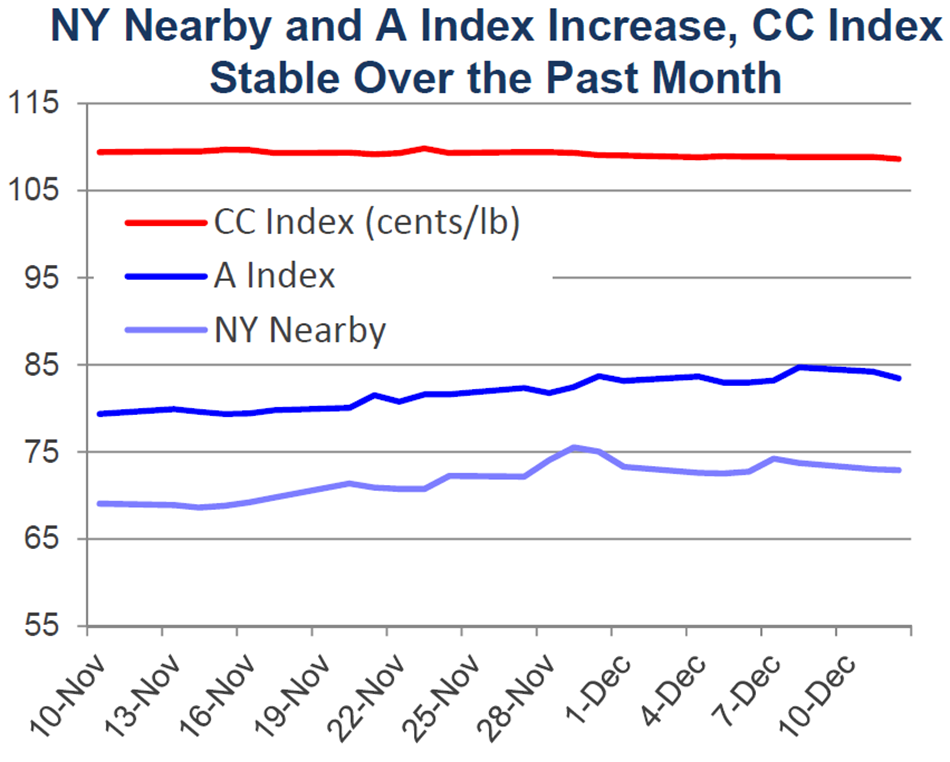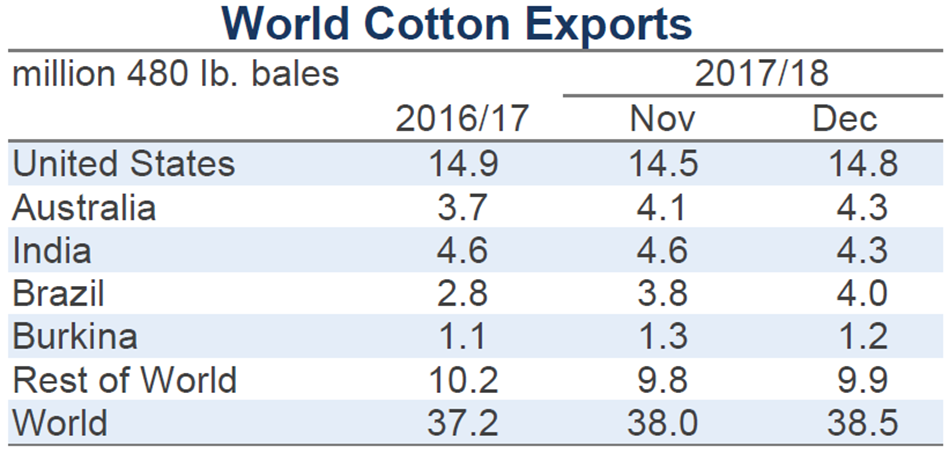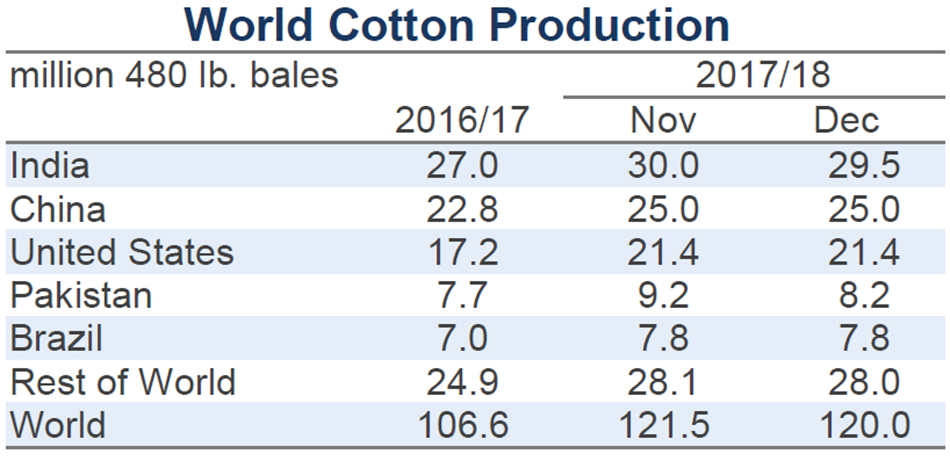Monthly Cotton Economic Letter (2017.12)
Jan 17, 2018 | by Flora
Recent price movement
Several benchmark prices increased over the past month. NY futures, the A Index, and Pakistani spot prices all rose a few cents/lb, while the CC Index and Indian spot prices were stable.
•The March NY futures contract was the most actively traded contract over the past month. Prices for March futures trended higher from late November through early December, bringing values out of the range between 66 and 70 cents/lb that had contained prices since mid-September. Recent price movement has been sideways at levels between 73 and 75 cents/lb.
•The A Index increased alongside NY futures, with values increasing from 79 to 83 cents/lb over the past month.
•The China Cotton Index (CC Index, base grade 3128B) held to levels near 109 cents/lb in international terms. In domestic terms, the CC Index eased slightly, falling from levels near 16,000 to those near 15,800 RMB/ton.
•Indian spot prices for the Shankar-6 quality were range bound, trading between 73 and 76 cents/lb over the past month. In domestic terms, Indian prices were generally near 38,000 INR/candy.
•Pakistani prices increased between early November and early December, rising from 72 to 76 cents/lb in international terms. In domestic terms, values climbed from 6,300 to 6,600 PKR/maund.
Supply, demand, & trade
This month’s USDA report featured a decrease to the global production forecast (-1.5 million bales, from 121.5 to 120.0 million) and an increase to the projection for global mill-use (+335,000 bales, from 119.3 to 119.6 million). Other revisions to global figures included a 1.0 million bale reduction in beginning stocks, which was a result of upward revisions to mill-use estimates over the past two crop years (these changes were concentrated on India). In combination, the reduction in beginning stocks, the lower production forecast, and the higher consumption estimate resulted in a 2.8 million bale decrease to the predicted level of world stocks at the end of the 2017/18 crop year (from 90.9 to 88.0 million).
While the size of this change is large, world ending stocks are still projected to be slightly bigger at the end of the current crop year than they were at the end of last crop year (87.7 million in 2016/17, 88.0 million in 2017/18). Importantly, the only major country expected to have a decrease in stocks in 2017/18 is China (from 48.4 million in 2016/17 to 39.7 million in 2017/18). For the collection of countries outside of China, where cotton is generally freely traded, stocks are still projected to reach a new record by a fairly wide margin (previous record of 44.2 million bales in 2014/15, 48.3 million bales forecast for 2017/18, implying the new record this crop year will be 4.1 million bales or about 10% larger). In the U.S., the world’s largest exporting country, ending stocks are predicted to more than double year-over-year (from 2.8 to 5.8 million bales).
At the country-level, the only notable increase to production figures was for Turkey (+200,000 bales, from 3.8 to 4.0 million). Globally, this increase was outweighed by reductions for Pakistan (-950,000 bales, from 9.2 to 8.2 million), India (-500,000 bales, from 30.0 to 29.5 million), Argentina (-120,000, from 1.1 to 0.9 million) Burkina Faso (-120,000, from 1.4 to 1.3 million), and Australia (-100,000, from 4.8 to 4.7 million).
Notable changes to consumption figures included those for India (+250,000 bales, from 24.5 to 24.8 million), Turkey (+250,000, from 6.8 to 7.0 million), Indonesia (+100,000, from 3.3 to 3.4 million), and Pakistan (-200,000, from 10.6 to 10.4 million). Figures for Indian mill-use over the past two crop years were also revised higher (+500,000 bales for both 2015/16 and 2016/17).
Global trade estimates were increased 450,000 bales, from 38.0 to 38.5 million. In terms of imports, this was primarily a result of increased expectations for Pakistan (+300,000 bales, from 2.4 to 2.7 million), Indonesia (+100,000, from 3.3 to 3.4 million), and Turkey (+100,000, from 3.4 to 3.5 million). In terms of exports, the largest country-level changes were for the U.S. (+300,000 bales, from 14.5 to 14.8 million), Brazil (+250,000, from 3.8 to 4.0 million), Australia (+200,000, from 4.1 to 4.3 million), Tajikistan (+100,000, from 300,000 to 400,000), Burkina Faso (-100,000, from 1.3 to 1.2 million), and India (-300,000, from 4.6 to 4.3 million).
Price outlook
Several reasons have been cited for the recent increases in cotton prices. Among them are crop concerns in India and Pakistan, the high level of export commitment from the U.S. (U.S. export sales are currently 2.7 million bales higher than they were at the same time last year and are forecast to be the second highest on record), the corresponding high level of unfixed on-call sales against NY futures, as well as speculation that China may increase imports. Nonetheless, stocks outside of China are expected to increase unambiguously this crop year, from 39.2 million bales at the end of 2016/17 to 48.3 million bales at the end of 2017/18. The substantial increase in stocks outside of China (+9.1 million bales, or +23%) suggests that prices should be decreasing instead of increasing.
This situation, where price movement and supply and demand forecasts are contradictory, parallels the situation at the same point in time last crop year, when stocks outside China, and particularly in the U.S., were expected to increase, and it looked like prices could be expected to move lower. As the crop year progressed, it became evident that supply and demand forecasts needed to be revised, with the most notable revisions centered on U.S. exports, where the strength of sales ultimately resulted in a decrease in U.S. stocks instead of the increase that was initially forecast.
By increasing, prices may be indicating that supply and demand forecasts will need to be significantly revised again this year. Perhaps the recent acceleration in global economic growth has resulted in greater mill-use. Perhaps China will increase its imports. Either scenario would imply less ending stocks outside of China than currently projected. However, it likely would take a combination of demand-side factors to add up to the 9.1 million bale increase in ending stocks projected to accumulate outside China. Whether or not those factors materialize in coming months, as more and more of the world’s cotton is harvested and prepared for sale/shipment, will shape price direction.






